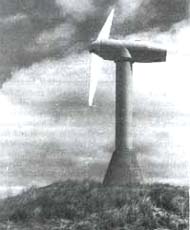Making a comeback
 WATCH out Don Quixote. The windmills are staging a comeback in Europe.
WATCH out Don Quixote. The windmills are staging a comeback in Europe.
Wind energy is the best alternative to reduce carbon dioxide levels in the atmosphere. By using windmills, the European Wind Energy Association (EWEA) believes that Europe will be able to churn out 4,000 mega watts (MW) of energy in the year 2000. The energy output could be increased to 11,500 MW by year 2005.
In 1882, Germany had 18,900 windmills which supplied as much as 1.8 per cent power used in the country amounting to 87 MW. Unfortunately, subsequent German technologies overshadowed the old ones. Even the biggest turbine, the Growian, which cost the country US $ 174 million, was a complete failure. It operated between 1983 and 1987 but could only manage to provide 420 hours of electricity. A lot of criticism came in from all the quarters and this setback took the European wind generator business some time to recover. Similarly, the US experiment also floundered. The US department of energy's Mod-2 programme could not take off. According to the reasons given by experts, Mod-2 failed because the emphasis was on size rather than on reliability.
To overcome the failures, the US government provided federal tax credit to the users of renewable energy, without realising that artificial systems of tax relief do not work. The result: California ended up with over 14,000 turbines, many of which had untested designs. In 1986,the tax incentives in US were withdrawn and the US market, which was largely based in California, collapsed. The matters became worse when the Danish home-market, which had a relitively better technology and captured 60 per cent of the world market collapsed. This was primarily because it was made mandatory for investors in wind energy to live in the municipality where the turbines were located.
The combination of German failure and the collapse of the US and Danish markets due to shortsighted government approach almost killed the wind turbine industry. In 1990s, various governments decided to intervene in favour of renewable energy and the industry was revived again. The Germans decided to pass a law which made it mandatory for renewable energy to be paid for at 90 per cent of the average utility price. Similarly in UK, the non-fossil fuel obligation (NFFO) arrangement and the liberalisation process helped, as did the Spanish PEN-91 plan. Measures like these gave confidence to the bankers and individual consumers to support the technology. The confidence is reflected in the fact that during the 1980s, the average capacity of the wind turbine was 55 kilp watt (KW), with a 15-metre rotor and a yearly production of 1,10,00 KW. Compared to this, in 1997, the average capacity increased to 600-1500 KW, with a 43-66 metre-long rotor. The yearly production has also increased to as much as 1,500 MWH. In other words, there has been a marked increase in efficiency and a 50 per cent fall in the costs.
A significant development in wind energy which has taken place during the last one decade has been the fact that a major change has taken place in the manufacturing and research and development. Major aerospace companies like Boeing, Grumman, MAN and MBB, along with electricity giants like Westinghouse are no longer there in the wind energy sector. The only familiar name left in the business is Mitsubishi of Japan, which has so far contributed 204 MW of energy. Now we find specialised firms with a history in agricultural machinery and shipbuilding playing a crucial role in the generation of wind energy.
All this has made the industry fiercely competitive. Some analysts have put the current global output at 2,300 MW a year, which is 35-40 per cent higher than the current requirements. Frost & Sullivan, a US consultancy company, believes that the global market for machines will grow from US $1.15 billion in 1997 to US $2.59 billion in 2004.
Technological advances are considered to be the root cause of market problems. As the average size of the turbine increases, the numbers will obviously decline, which in turn leads to a reduction in the price of the electricity. As a result, some of the manufacturers find it difficult to survive in the market. Added to this is the issue of aesthetics. The chief executive of the EWEA says, "It is better for the eye to have five machines running slowly than to have 20 turning very fast." He also argues that landscape presents the biggest problem to the development of the wind energy.
Noise, interference with TV reception and killing of birds have raised the debate about the future of role of wind energy. Experts are attempting to move the sites to offshore as a solution to the above problems. The biggest offshore site at present is the 28 Nordtank 600 KW machines near Dronton in Denmark.
Wind energy has still not overcome many of its problems. It is expensive and needs government support. There are also problems associated with landscaping. But there have been significant advances in technology in the recent past, with machines becoming cheaper, quieter, and relatively powerful than they were in the past. And the way things stand today, the world will definitely have many more windmills in the coming future.
